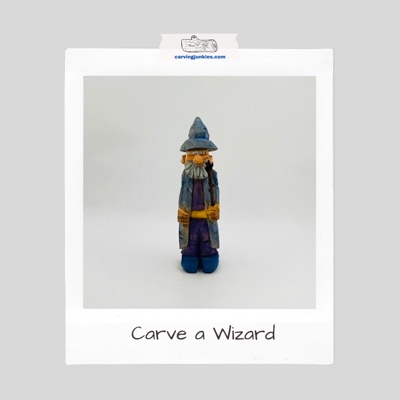- Home
- Things to carve
- Wizard wood carving
Wonderful wizard wood carving tutorial
This old-world wizard is fun to carve.
If you want to create an awesome wizard wood carving, this fun tutorial is for you.
He features a Gandalf-inspired look and feel. If you’ve never read the Hobbit or Lord of the Rings, they are worth your time.
This wizard caricature has just enough detail to make him interesting without making him too challenging to carve.
The wand is simply a small twig from a tree that is easy to attach and gives him more character.
What you will need for this wizard wood carving
For this wizard wood carving tutorial, you will need a block of wood (I used basswood) that is 1 x 1 x 4 inches (2.5 x 2.5 x 10.1 cm).
Use your knives of choice (you may want a larger blade for your roughout and a detail knife for the face). A U gouge will come in handy for the ears and a V-tool will be helpful for the hair and beard. If you don’t have these tools, you can still carve these areas with a sharp detail knife.
A pin vise is optional if you want to carve a hole in the wizard’s hand.
Protect your hands with carving gloves, as well as your lap as you carve (a piece of wood or cutting board will work).
I used magic marker so you can see the guidelines, but a pencil and an eraser will work best for you.
As always, a painting and finishing guide are are included at the end of this page.
Wizard wood carving tutorial at-a-glance
Watch the key steps to make the wizard wood carving in this short video.
Starting your wizard wood carving
I created a template to help guide your cuts (also included at the end of this page). Photocopy the template to size, cut it out, and trace it on the right and left sides of your wood block.
Remember to turn the template over to be sure the head and body on both sides are pointed in the right direction (photos 1,3).
You can carve directly from the wood block (or use a bandsaw to create a larger roughout with our free pattern).
You may also want to add some guidelines on the front and back to mark key sections where you will be making V-cuts to remove wood (photos 2,4).
For example, I added guidelines in the middle of sections where I made V-cuts to remove wood (such as the front and the back of the neck, and the top of the shoes).
To add these guidelines, find the middle of the section on each side and simply draw a line across the front or back.
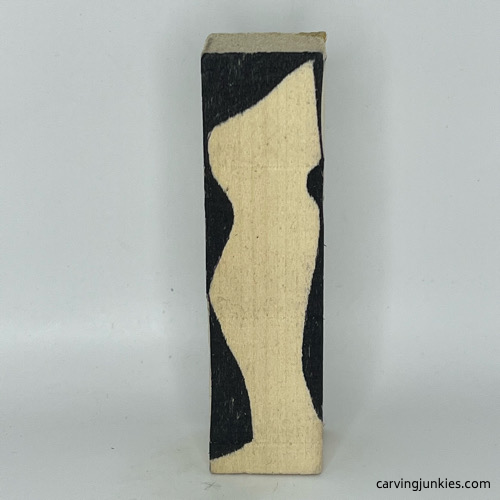 1. Left view of the pattern
1. Left view of the pattern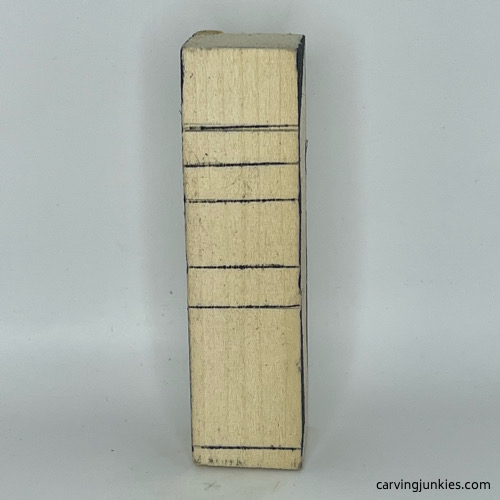 2. Front guidelines extended from template
2. Front guidelines extended from template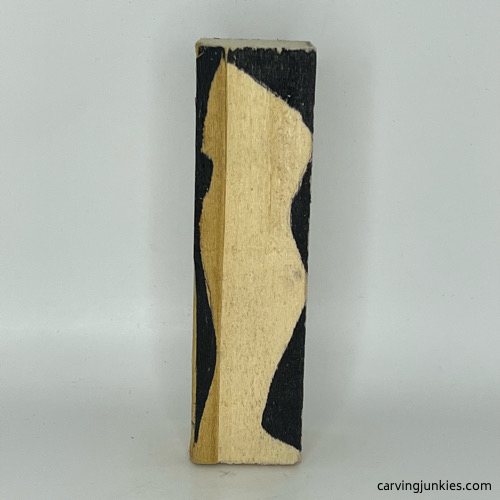 3. Right view of the pattern
3. Right view of the pattern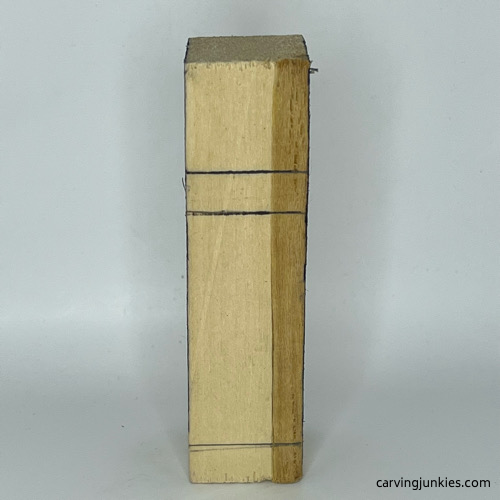 4. Back guidelines extended from template
4. Back guidelines extended from templateStarting your wizard wood carving
First, you will roughout the bock by making a series of cuts that will provide the shape of the wizard’s body.
Your first cuts will be to carve back the hat and head (photos 5-7). You can use a push or pull cut here. Just be sure you are carving with the grain (you may have to turn your piece around as you carve).
Continue to remove the marked wood around the pattern to complete your roughout of the wizard. When you are done, add guidelines to mark the bottom of the hat and the bottom of the head all around (photos 5,6).
Use a stop cut (photo 8) and remove wood underneath to separate the hat all around (photo 9). Save carving the brim for last to prevent breaking it.
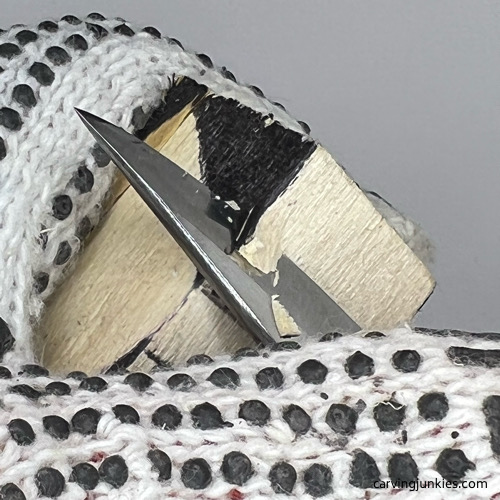 5. Carving back the head
5. Carving back the head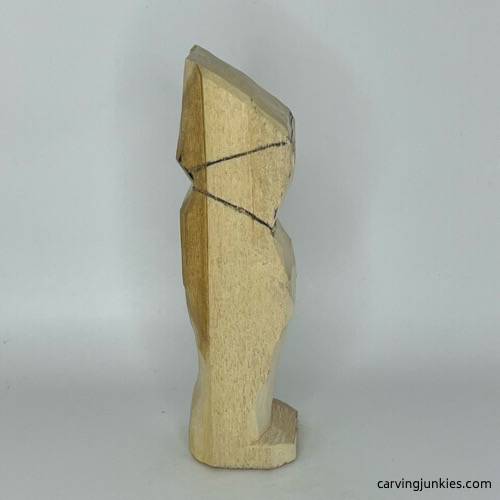 6. Right view of roughout
6. Right view of roughout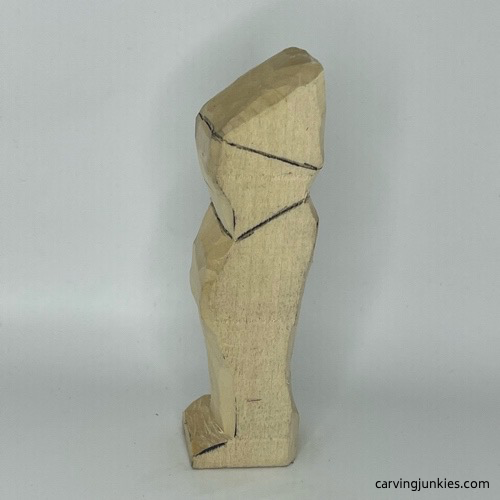 7. Left view of roughout
7. Left view of roughout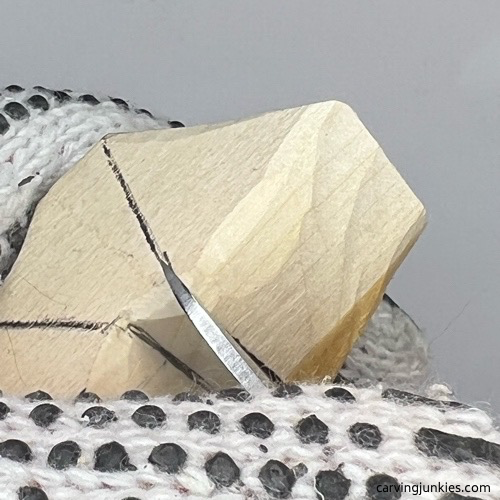 8. Making a stop cut
8. Making a stop cut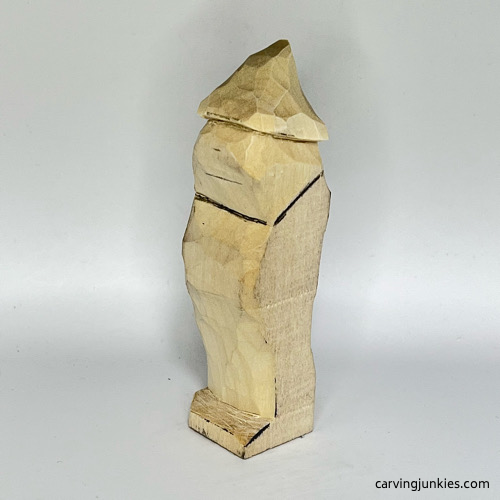 9. Hat is shaped
9. Hat is shapedSeparate the head of the wizard wood carving
Use stop cuts to separate the head from the body all around (photo 10). Then, use your knife to make the head more oval in shape (photo 10).
Add an ear box on each side of the head (photos 11,12) that is 1/4-inch by 1/4-inch (0.64 cm x 0.64 cm). Also set up the nose box, which is about 1/2-inch wide at the top (photo 10).
You will carve the nose using the carvingjunkies’ triangle-by-triangle nose carving system. It makes it easy to get a perfect nose every time. I will explain the steps as you carve.
First, separate each ear box. Move your knife along the guideline to make your first cut (photo 13). Make a second slicing cut (photo 14) to remove wood underneath (or around) your first cut.
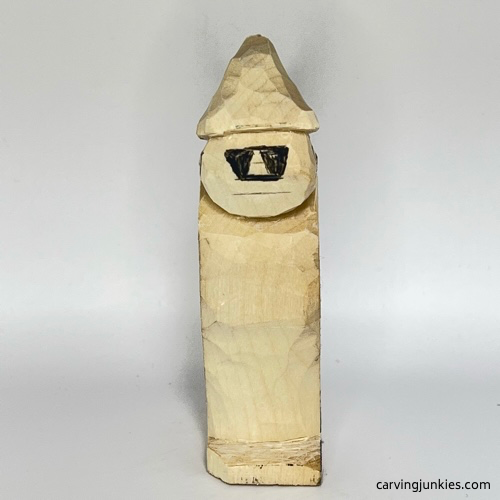 10. Nose box is drawn
10. Nose box is drawn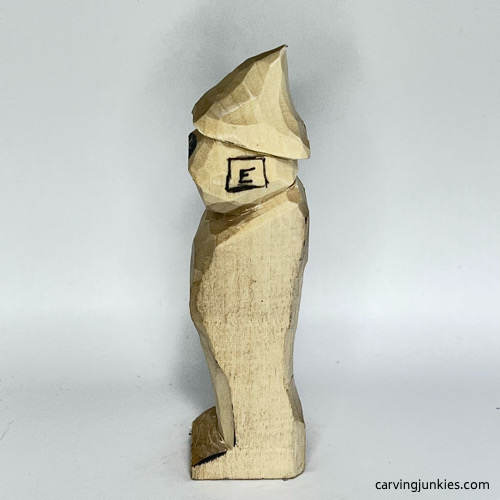 12. Left ear box
12. Left ear box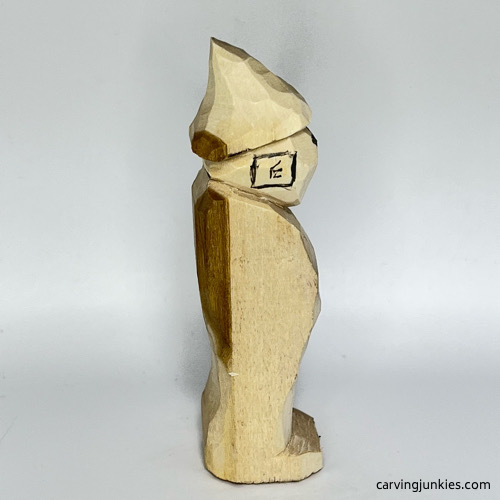 11. Right ear box
11. Right ear box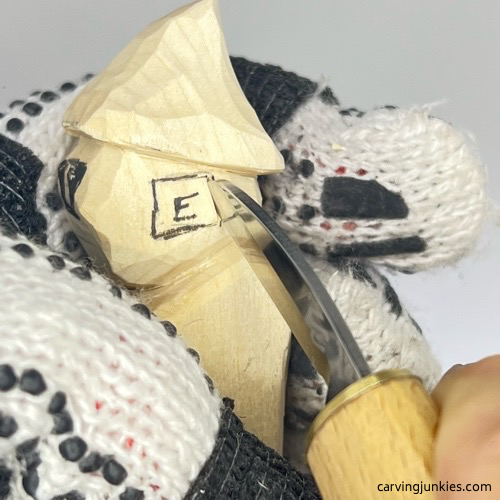 13. Separating the ear box
13. Separating the ear box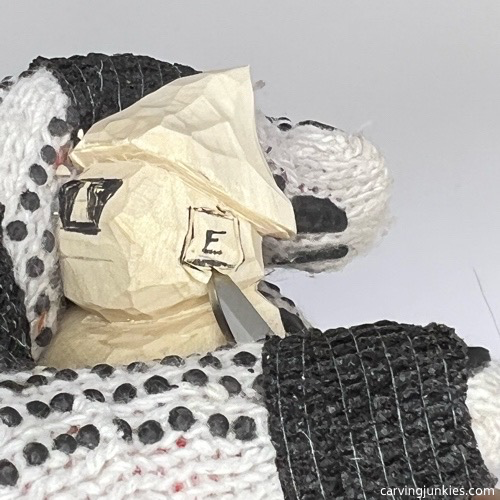 14. Making second slicing cut
14. Making second slicing cutCarve the nose on the wizard wood carving
Make a stop cut under the nose box (photo 15). Make a pyramid cut on each side of the nose (started in photo 16) to cleanly remove a triangular chip. Tip: You can easily clean up your cut if it’s less than perfect.
After completing the two pyramid cuts, shape the nose on each side by slicing a little wood off (completed in photo 17).
Also, shape the bridge of the nose by making an angled cut (completed in photo 16).
Plunge your knife into the wood on each side (above the nose) to make a single cut for each eye (photo 17). This carving will just have the suggestion of eyes.
Draw on some details, including the wizard’s cheeks, the top of his beard, mouth line, arms and hands, robe, waist sash, and pants (photos 18-21).
On the back of the wizard, the pants will be a little longer (photos 18,19). On the front, mark where you will split the legs, and on the back, mark where you will split the shoes (photos 18, 21).
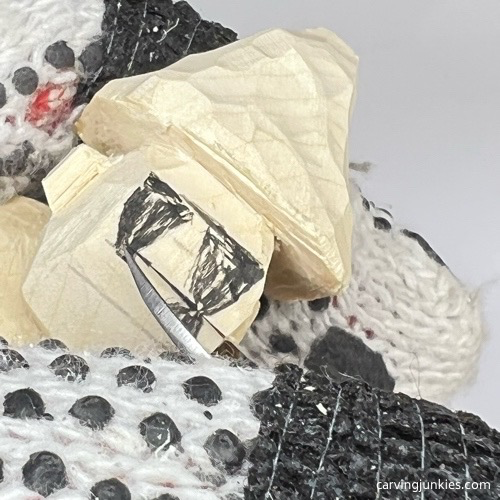 15. Making a stop cut
15. Making a stop cut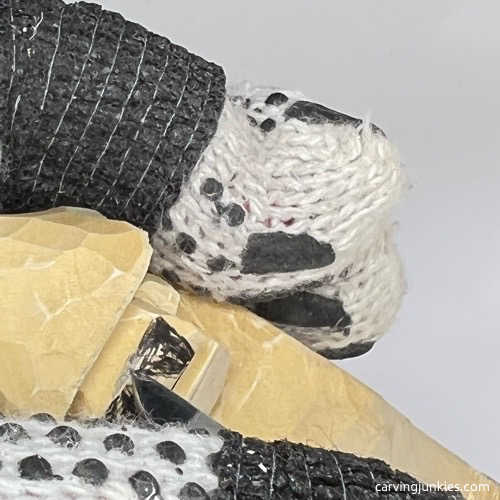 16. Starting a pyramid cut
16. Starting a pyramid cut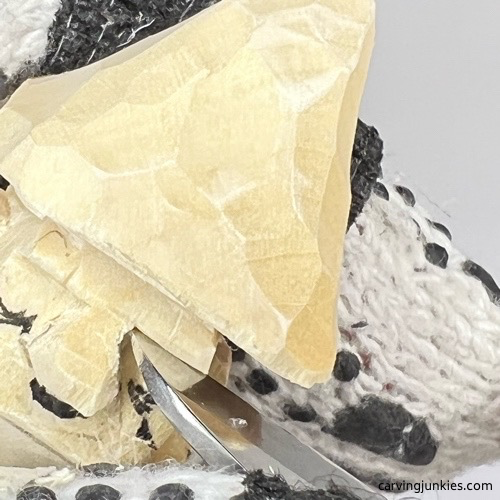 17. Creating eyes with plunging cut
17. Creating eyes with plunging cut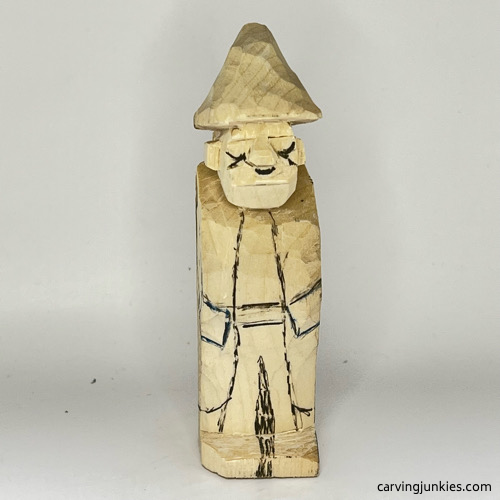 18. Details are drawn
18. Details are drawn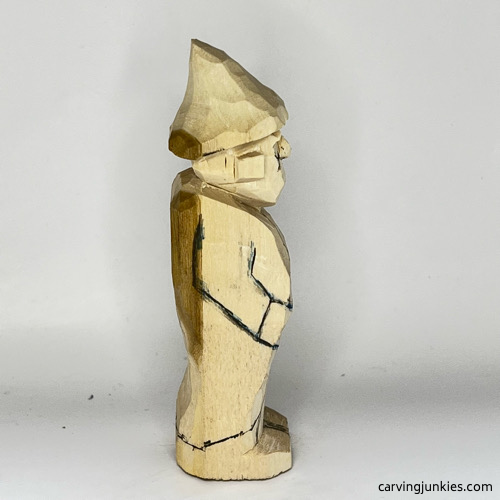 19. Right side view of pants
19. Right side view of pants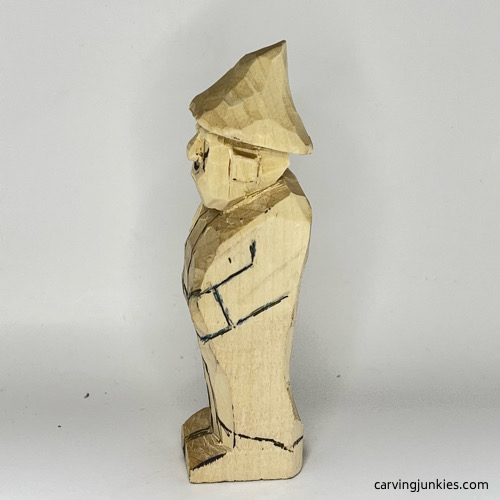 20. Left side view of pants
20. Left side view of pants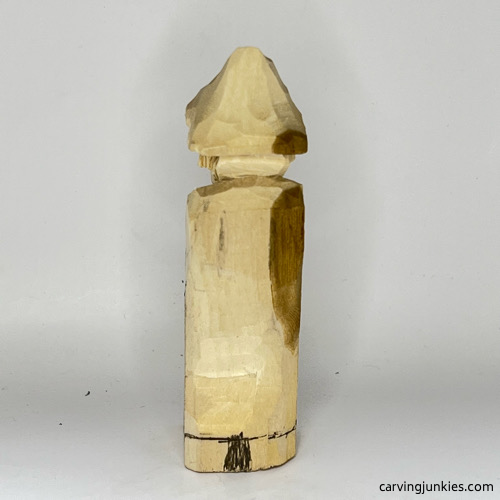 21. Back guideline to split shoes
21. Back guideline to split shoesShape the body of your wizard wood carving
Remove some excess wood off the back of the arms (photo 22) and from the front shoulders of the wizard wood carving (photo 23). Separate the hands and arms, starting underneath the hands on each side (photo 24). You can use stop cuts here.
Make a pyramid cut (photo 25) to remove wood from the front crook of the arm (or use stop cuts but you may have to make more than one cut). Check for symmetry in shape on each arm as you go.
Move your knife along the guideline for the robe, from the top to the bottom, and remove wood from in between your cuts (completed in photo 26).
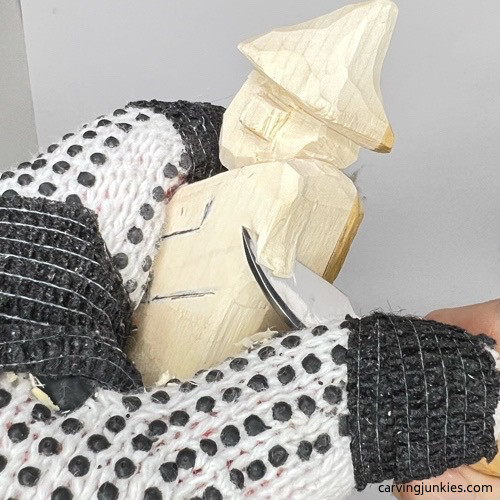 22. Removing excess wood from back
22. Removing excess wood from back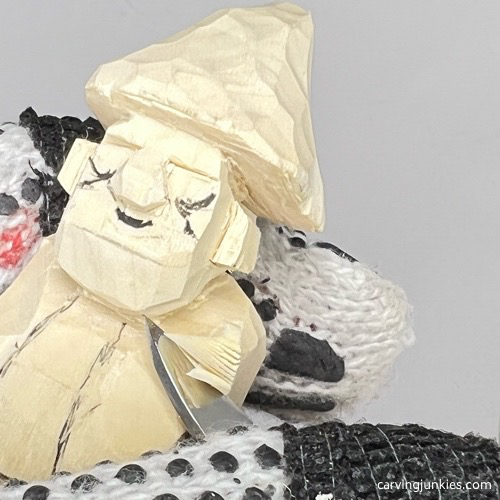 23. Shaping back front shoulder
23. Shaping back front shoulder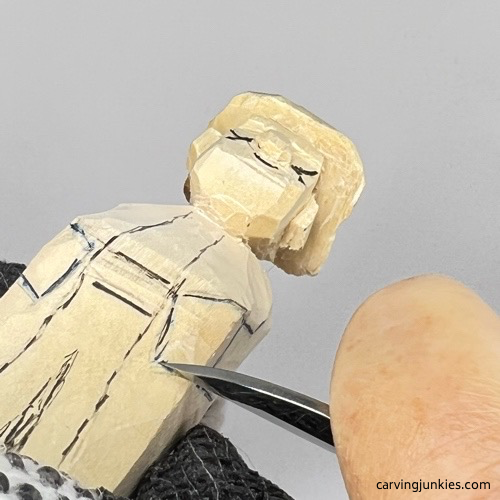 24. Separating hand and arm
24. Separating hand and arm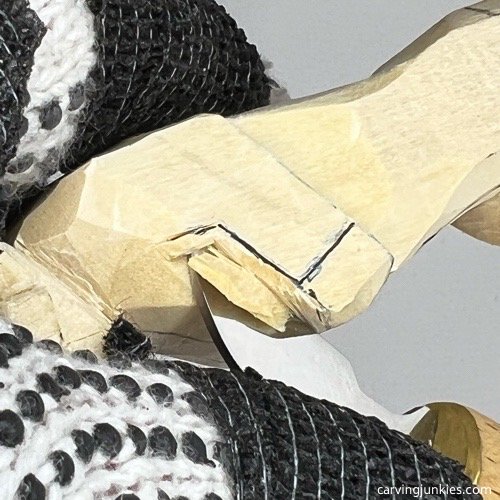 25. Carving crook of arm
25. Carving crook of arm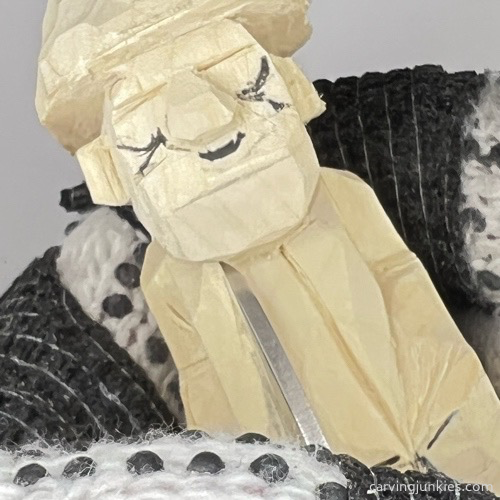 26. Separating the robe
26. Separating the robeCarve some details on your wizard wood carving
Use a V-cut (photo 27) to separate the legs/pants on the front and the shoes on the back (the robe will cover up the pants on the back).
Draw your knife along the guideline for the cheeks and remove wood from underneath (photo 28). You may want to switch to a smaller, detail knife here.
Also, carefully use your knife to make a series of V-cuts (photo 29) to carve the beard, eyebrows, and the hair in the back (Tip: if you have a V-tool this is the place to use it).
Make a stop cut along the back shoulder blades (photo 30) and remove wood from in between the shoulder blades.
Draw a line about a 1/4-inch (0.6 cm) above the bottom of the hat to start the brim (visible in photo 31). Carefully use stop cuts and remove wood from underneath. Continue to shape the hat (be very careful not to break the brim as you remove wood) until it looks like photo 32.
Use a U-gouge to scoop out the middle of each ear. Slice wood off the corners to round each ear. Tip: If you don’t have a gouge, make a small V-cut in the middle of each ear or try a scooping cut.
Draw the lapels on the front of the robe (photo 33). Make a stop cut and remove wood from underneath.
Draw the fingers on each hand and carefully make small V-cuts to separate them (completed in photo 35).
Optional: Use a pin vise to drill a small hole in the hand of the wizard (photo 34). Tip: Angle your vise toward the body to avoid breaking the hand.
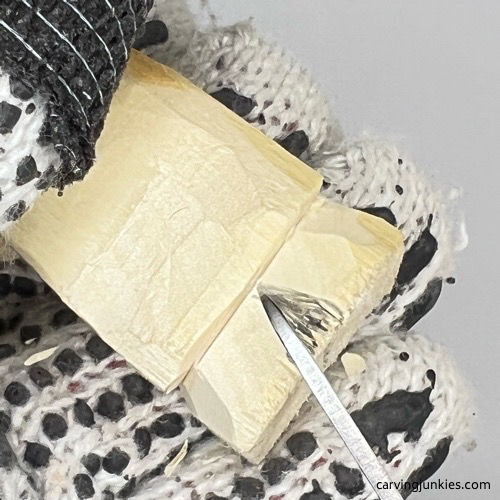 27. Separating legs on the back
27. Separating legs on the back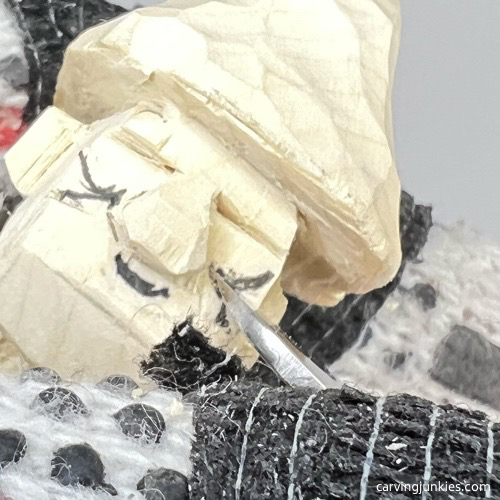 28. Carving the cheeks
28. Carving the cheeks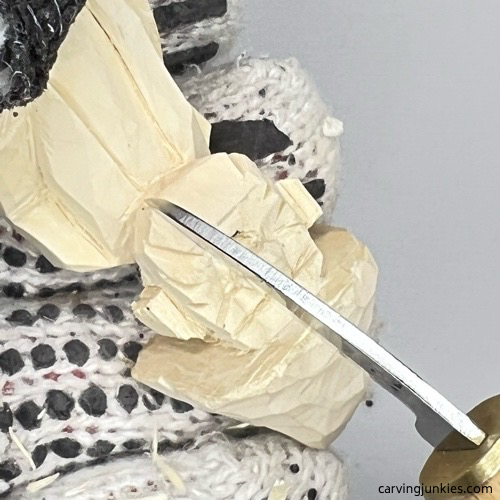 29. Carving the beard
29. Carving the beard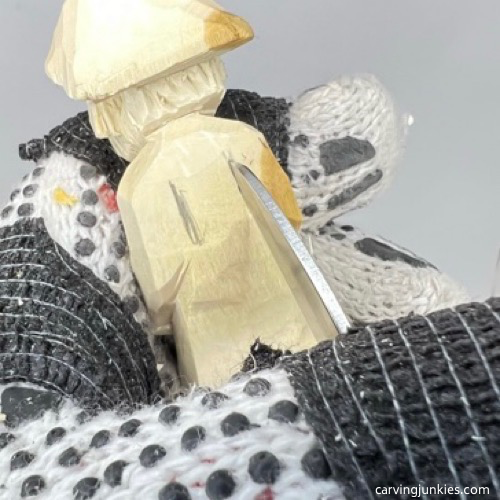 30. Cutting the back shoulder blades
30. Cutting the back shoulder blades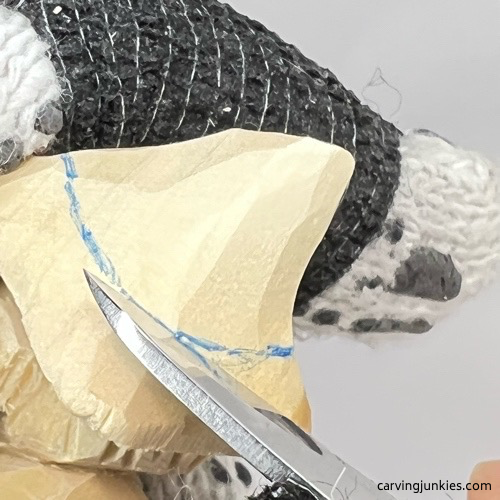 31. Separating the hat brim
31. Separating the hat brim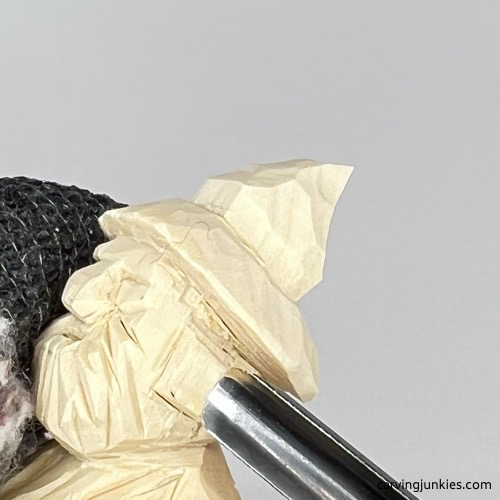 32. Shaping the ear
32. Shaping the ear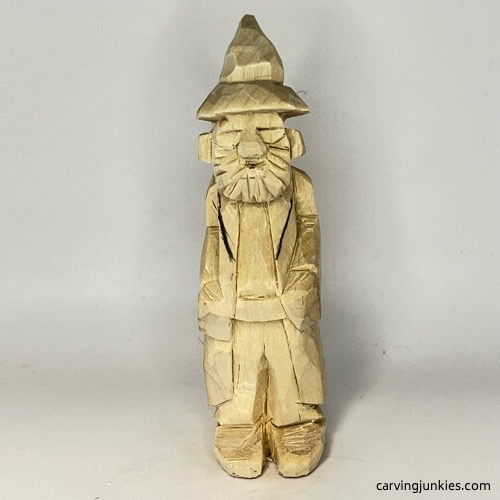 33. Adding the robe lapels
33. Adding the robe lapels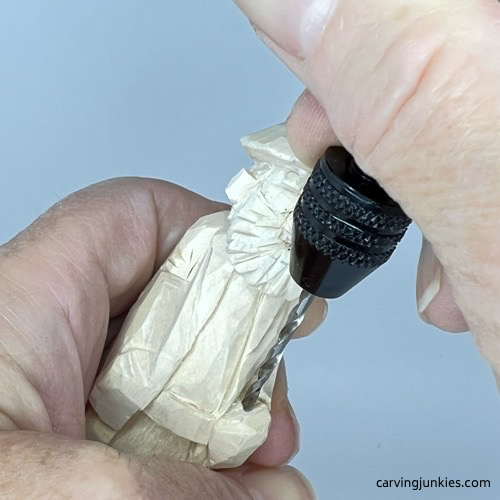 34. Drilling hole in the hand
34. Drilling hole in the handFinish the details on your wizard wood carving
Shape the shoes and use V-cuts to carve the heels (completed in photos 36,37). Tip: Sketch the shape of the shoe and color the wood where you want to cut the heel.
Use V-cuts to add some wrinkles to the elbows, hat, robe, and knees of the pants (photos 35-38). Tip: Make some V-cuts wider than others to add visual interest.
Finally, use your knife to deepen cuts between sections where you will change paint color, such as the robe, waist sash, and pants.
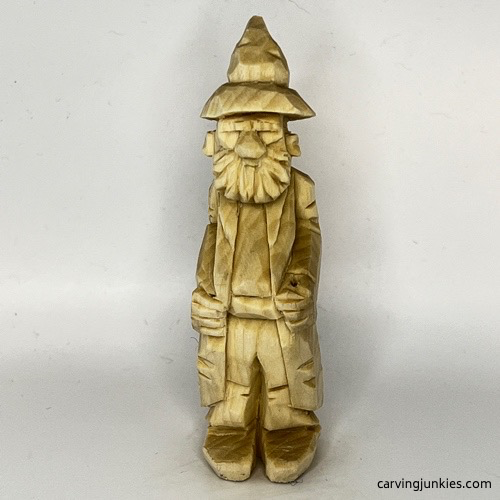 35. Front of unpainted wizard
35. Front of unpainted wizard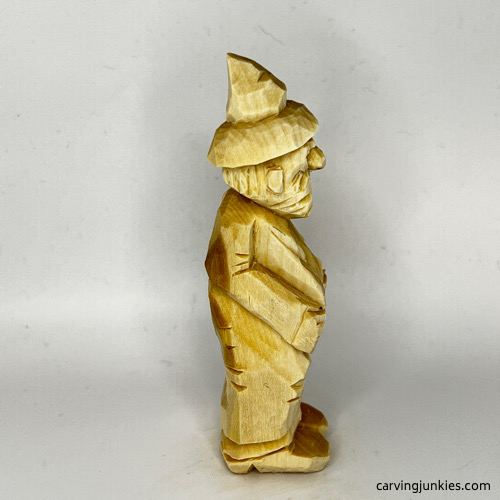 36. Right view of unpainted wizard
36. Right view of unpainted wizard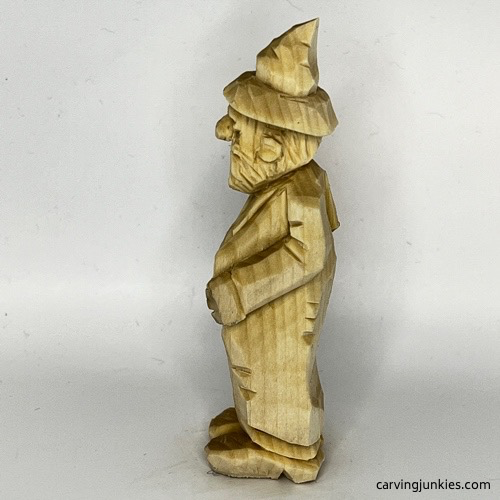 37. Left view of unpainted wizard
37. Left view of unpainted wizard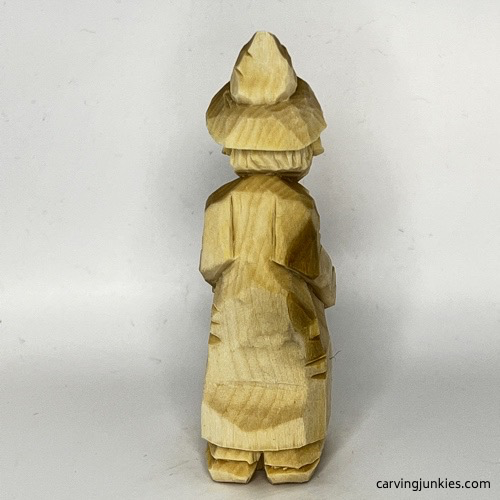 38. Back of unpainted wizard
38. Back of unpainted wizardPaint your wizard wood carving
Before you paint your wizard wood carving, check to be sure all your cuts are clean (Tip: you can use sandpaper on uneven cuts).
Use whatever paints and paint brushes you want. I use acrylic paints and typically create a wash by pulling a little paint into a container with water.
Be sure to let each coat of paint dry completely before starting a new section. Tip: A hair dryer can help speed the drying up.
- First layer of the entire carving: Academy burnt sienna wash (be sure it’s super diluted with water).
- Robe: Apple Barrel blueberry frost wash.
- Shirt and pants: CraftSmart purple wash.
- Face and hands: Ceramcoat tawny light wash.
- Waist sash: Ceramcoat bright yellow (100% paint).
- Shoes (and creases of the robe): Apple Barrel blueberry frost (100% paint).
- Beard, mustache, hair, and eyebrows: Ceramcoat dolphin gray (100% paint). Drybrush with CraftSmart ivory.
- Finish: Howard’s Feed ‘N Wax polish.
- Optional: staff/wand: Glue a twig of wood into the whole in the hand after painting.
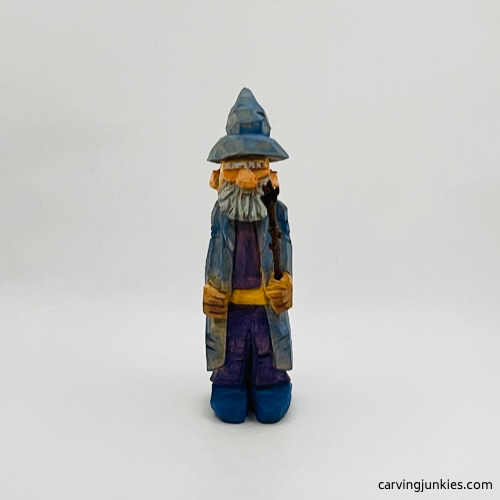 39. Front view of painted wizard
39. Front view of painted wizard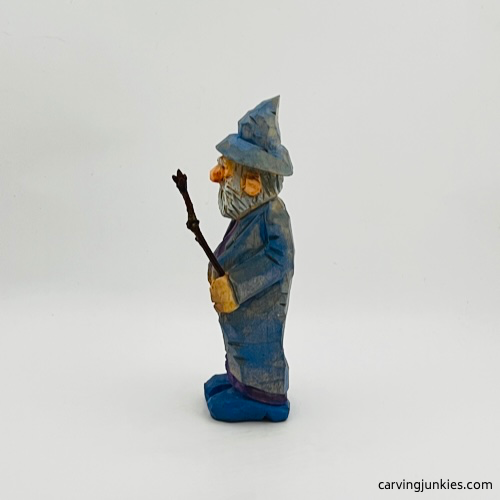 41. Left view of painted wizard
41. Left view of painted wizard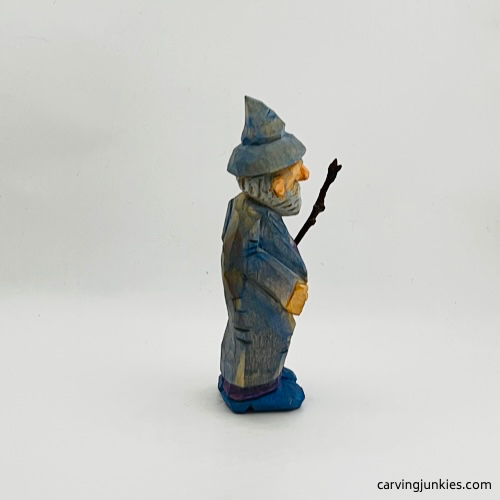 40. Right view of painted wizard
40. Right view of painted wizard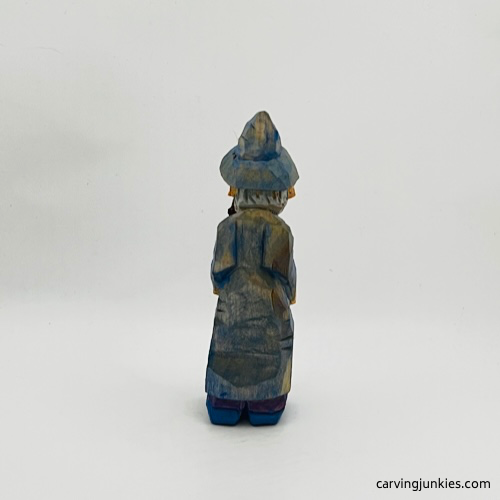 42. Back view of painted wizard
42. Back view of painted wizardFree wizard wood carving template and pattern
Photocopy the green template below to size to fit (and trace onto) your wood block.
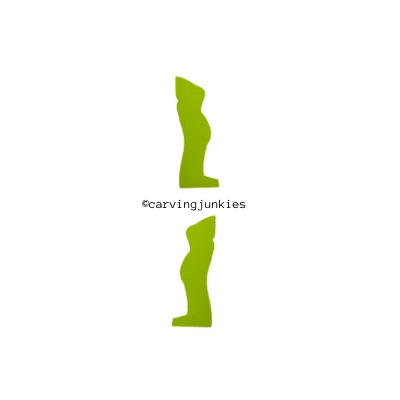 Template for wizard wood carving
Template for wizard wood carvingWizard wood carving tutorial summary
- This wizard wood carving tutorial helps you create an old world wizard with a beard.
- Making a hole in the hand allows you to add a magic wand, or a wooden staff (optional).
- You can complete this piece with only a knife, but a U-gouge for the ears—and a V-tool for carving the beard, eyebrows, and hair— will be easier.
Get 50 Wood Carving & Painting Tips when you join our FREE Covered in Chips club.
Share this page
carvingjunkies.com never sells your personal information.
This site uses cookies for its operation and to enhance your experience. As an Amazon Associate and Focuser Carving affiliate we earn from qualifying purchases.
Home | About Us | Privacy Policy | Terms of Use | Contact | Sitemap
